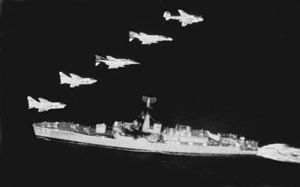
HMAS Duchess was a Daring-class destroyer that served in the Royal Navy as HMS Duchess from 1952 to 1964, and in the Royal Australian Navy (RAN) from 1964 to 1980. She was laid down by John I. Thornycroft and Company, and commissioned into the Royal Navy in 1952.

HMAS Melbourne (R21) was a Majestic-class light aircraft carrier operated by the Royal Australian Navy (RAN) from 1955 until 1982, and was the third and final conventional aircraft carrier to serve in the RAN. Melbourne was the only Commonwealth naval vessel to sink two friendly warships in peacetime collisions.
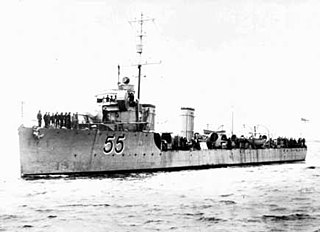
HMAS Parramatta, named after the Parramatta River, was a River-class torpedo-boat destroyer of the Royal Australian Navy (RAN). Ordered in 1909 for the Commonwealth Naval Forces, Parramatta was the first ship launched for the RAN. Temporarily commissioned into the Royal Navy for the delivery voyage to Australia, the destroyer came under Australian naval control in 1910, and was recommissioned into the RAN on 1 March 1911, shortly before the latter's formal creation.

HMAS Sydney (R17/A214/P214/L134) was a Majestic-class light aircraft carrier operated by the Royal Australian Navy (RAN). She was built for the Royal Navy and was launched as HMS Terrible (93) in 1944, but was not completed before the end of World War II. The carrier was sold to Australia in 1947, completed, and commissioned into the RAN as Sydney in 1948.
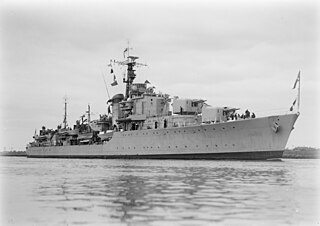
HMAS Anzac (D59) was a Battle-class destroyer of the Royal Australian Navy (RAN). Named after the Australian and New Zealand Army Corps, the destroyer was commissioned in 1951. The ship served on two tours of duty during the Korean War, and attempts to distinguish herself from British ships led to the practice of red kangaroo symbols on Australian warships. During 1956, Anzac served during the Malayan Emergency. In 1960, a malfunction in the destroyer's gun direction equipment caused Anzac to fire directly on sister ship HMAS Tobruk during a gunnery exercise, with Tobruk left unrepairable. In 1961, the destroyer was reclassified as a training vessel. Anzac remained in service until 1974, and was sold for breaking a year later.

HMAS Vampire was the third of three Australian-built Daring-class destroyers serving in the Royal Australian Navy (RAN). One of the first all-welded ships built in Australia, she was constructed at Cockatoo Island Dockyard between 1952 and 1959, and was commissioned into the RAN a day after completion.

The Cockatoo Island Dockyard was a major dockyard in Sydney, Australia, based on Cockatoo Island. The dockyard was established in 1857 to maintain Royal Navy warships. It later built and repaired military and battle ships, and played a key role in sustaining the Royal Australian Navy. The dockyard was closed in 1991, and its remnants are heritage listed as the Cockatoo Island Industrial Conservation Area.
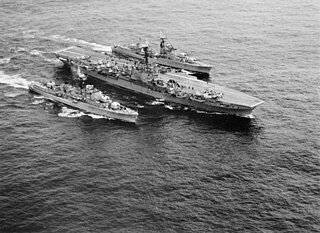
HMAS Vendetta was one of three Daring-class destroyers built for and operated by the Royal Australian Navy (RAN). The destroyer was built by Williamstown Naval Dockyard and entered service in 1958. During her early career, Vendetta was deployed to the Far East Strategic Reserve on multiple occasions. In 1965 and 1966, the destroyer undertook deterrence patrols during the Indonesia-Malaysia Confrontation. Along with several runs escorting the troop transport HMAS Sydney to South Vietnam, from late 1969 to early 1970 Vendetta was assigned to combat operations and became the only Australian-built warship to serve in a shore bombardment role during the Vietnam War.

HMAS Derwent, named for the Derwent River, was a River-class destroyer escort of the Royal Australian Navy (RAN). She was laid down by Williamstown Naval Dockyard in 1959, and commissioned into the RAN in 1964. During the ship's career, she was deployed to South East Asia on 23 occasions, including operations during the Indonesia-Malaysia Confrontation, and escort of the troopship HMAS Sydney to and from the Vietnam War. Multiple flag-showing cruises were also embarked upon, with port visits throughout Asia, the Indian Ocean, and the Pacific Ocean. Derwent was also briefly used to portray a fictional vessel for the British drama series Warship.

HMAS Torrens was a River-class destroyer escort of the Royal Australian Navy (RAN). Torrens entered service in 1971, and was active until her decommissioning in 1998.

HMAS Yarra, named for the Yarra River, was a River-class torpedo-boat destroyer of the Royal Australian Navy (RAN). Ordered in 1909 for the Commonwealth Naval Forces, Yarra was temporarily commissioned into the Royal Navy on completion in 1910 and handed over to Australian control on arrival in Australia.

HMAS Kuttabul is a Royal Australian Navy (RAN) base located in Potts Point in Sydney, New South Wales, Australia. Kuttabul provides administrative, training, logistics and accommodation support to naval personnel assigned to the various facilities that form Fleet Base East, the main operational navy base on the east coast of Australia. A part of Fleet Base East itself, Kuttabul occupies several buildings in the Sydney suburb of Potts Point and in the immediately adjacent Garden Island dockyard. It also supports navy personnel posted to other locations throughout the greater Sydney region.

HMAS Jervis Bay was a roll-on/roll-off passenger and vehicle ferry operated by the Royal Australian Navy (RAN) between 1977 and 1994.
The British Commonwealth Far East Strategic Reserve was a joint military force of the British, Australian, and New Zealand armed forces. Created in the 1950s and based in Malaya, the FESR was conceived as a forward defence point for Australia and New Zealand, while protecting Commonwealth interests in the Southeast Asian region from both internal and external communist threats. The FESR was made up of an infantry brigade and an aircraft carrier group, supported by squadrons of aircraft.

The history of the Royal Australian Navy traces the development of the Royal Australian Navy (RAN) from the colonisation of Australia by the British in 1788. Until 1859, vessels of the Royal Navy made frequent trips to the new colonies. In 1859, the Australia Squadron was formed as a separate squadron and remained in Australia until 1913. Until Federation, five of the six Australian colonies operated their own colonial naval force, which formed on 1 March 1901 the Australian Navy's (AN) Commonwealth Naval Force which received Royal patronage in July 1911 and was from that time referred to as Royal Australian Navy (RAN). On 4 October 1913 the new replacement fleet for the foundation fleet of 1901 steamed through Sydney Heads for the first time.

HMAS Parramatta (U44) was a Grimsby class sloop of the Royal Australian Navy (RAN). Built during the late 1930s, Parramatta operated in the Red Sea and Mediterranean during World War II. The sloop was torpedoed by the German submarine U-559 on 27 November 1941, and sank with 138 of the 162 aboard.
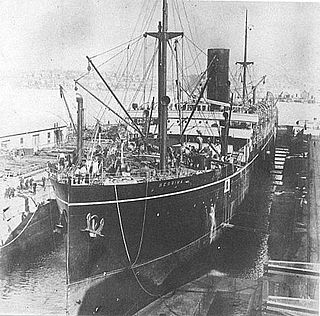
HMAS Berrima was a passenger liner which served in the Royal Australian Navy (RAN) during World War I as an armed merchantman and troop transport. Launched in 1913 as the P&O liner SS Berrima, the ship initially carried immigrants from the United Kingdom to Australia via Cape Town. In August 1914, Berrima was requisitioned for military use, refitted and armed, and commissioned into the RAN as an auxiliary cruiser. The ship transported two battalions of the Australian Naval and Military Expeditionary Force to the German New Guinea colonies in September.

The State Dockyard was a ship building and maintenance facility operated by the Government of New South Wales in Carrington, Newcastle, New South Wales, Australia between 1942 and 1987.

HMAS Jeparit was an Australian National Line (ANL) bulk carrier which was operated by the Royal Australian Navy (RAN) between 1969 and 1972. She was launched in 1964 and transported supplies to Australian military forces in South Vietnam between 1966 and 1972 under both civil and military ownership. She returned to service with ANL in 1972, being sold in 1979 to a Greek shipping company and renamed Pleias. She continued in civilian service under several names before being broken up in 1993.
The Cockatoo Docks & Engineering Company was a ship building and maintenance company which operated the Cockatoo Island Dockyard on Cockatoo Island in Sydney, Australia, between 1933 and 1992.
